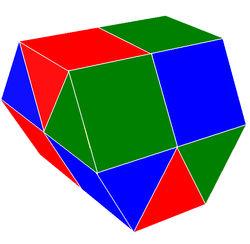Hexagonal prismatic honeycomb
| Hexagonal prismatic honeycomb |
|---|
| Type | Uniform honeycomb |
| Schläfli symbols | {6,3}×{∞} or t0,1,3{6,3,2,∞} |
| Coxeter diagrams |         
        
      
|
| Cell types | 4.4.6 |
| Vertex figure | triangular bipyramid |
Space group
Coxeter notation | [6,3,2,∞]
[3[3],2,∞] |
| Dual | Triangular prismatic honeycomb |
| Properties | vertex-transitive |
The hexagonal prismatic honeycomb or hexagonal prismatic cellulation is a space-filling tessellation (or honeycomb) in Euclidean 3-space made up of hexagonal prisms.
It is constructed from a hexagonal tiling extruded into prisms.

It is one of 28 convex uniform honeycombs.
This honeycomb can be alternated into the gyrated tetrahedral-octahedral honeycomb, with pairs of tetrahedra existing in the alternated gaps (instead of a triangular bipyramid).
There are 1 + 3 + 1 = 5 edges meeting at a vertex, 3 Hexagonal Prism cells meeting at an edge, and faces are shared between 2 cells.
Truncated hexagonal prismatic honeycomb
| Truncated hexagonal prismatic honeycomb |
|---|
| Type | Uniform honeycomb |
| Schläfli symbol | t{6,3}×{∞} or t0,1,3{6,3,2,∞} |
| Coxeter diagram |          |
| Cell types | 4.4.12 
3.4.4  |
| Face types | {3}, {4}, {12} |
| Edge figures | Square,
Isosceles triangle |
| Vertex figure | Triangular bipyramid |
Space group
Coxeter notation | [6,3,2,∞] |
| Properties | vertex-transitive |
The truncated hexagonal prismatic honeycomb or tomo-trihexagonal prismatic cellulation is a space-filling tessellation (or honeycomb) in Euclidean 3-space. It is composed of dodecagonal prisms, and triangular prisms in a ratio of 1:2.

It is constructed from a truncated hexagonal tiling extruded into prisms.
It is one of 28 convex uniform honeycombs.
Rhombitrihexagonal prismatic honeycomb
| Rhombitrihexagonal prismatic honeycomb |
|---|
| Type | Uniform honeycomb |
| Vertex figure | Trapezoidal bipyramid |
| Schläfli symbol | rr{6,3}×{∞} or t0,2,3{6,3,2,∞}
s2{3,6}×{∞} |
| Coxeter diagram |         
         |
Space group
Coxeter notation | [6,3,2,∞] |
| Properties | vertex-transitive |
The rhombitrihexagonal prismatic honeycomb or rhombitrihexagonal prismatic cellulation is a space-filling tessellation (or honeycomb) in Euclidean 3-space. It is composed of hexagonal prisms, cubes, and triangular prisms in a ratio of 1:3:2.

It is constructed from a rhombitrihexagonal tiling extruded into prisms.
It is one of 28 convex uniform honeycombs.
Gyrated triangular prismatic honeycomb
The gyrated triangular prismatic honeycomb or parasquare fastigial cellulation is a space-filling tessellation (or honeycomb) in Euclidean 3-space made up of triangular prisms. It is vertex-uniform with 12 triangular prisms per vertex.


It can be seen as parallel planes of square tiling with alternating offsets caused by layers of paired triangular prisms. The prisms in each layer are rotated by a right angle to those in the next layer.
It is one of 28 convex uniform honeycombs.
Pairs of triangular prisms can be combined to create gyrobifastigium cells. The resulting honeycomb is closely related but not equivalent: it has the same vertices and edges, but different two-dimensional faces and three-dimensional cells.
Gyroelongated triangular prismatic honeycomb
The gyroelongated triangular prismatic honeycomb or elongated parasquare fastigial cellulation is a uniform space-filling tessellation (or honeycomb) in Euclidean 3-space. It is composed of cubes and triangular prisms in a ratio of 1:2.


It is created by alternating layers of cubes and triangular prisms, with the prisms alternating in orientation by 90 degrees.
It is related to the elongated triangular prismatic honeycomb which has the triangular prisms with the same orientation.
This is related to a space-filling polyhedron, elongated gyrobifastigium, where cube and two opposite triangular prisms are augmented together as a single polyhedron:
-

This page is based on this
Wikipedia article Text is available under the
CC BY-SA 4.0 license; additional terms may apply.
Images, videos and audio are available under their respective licenses.













